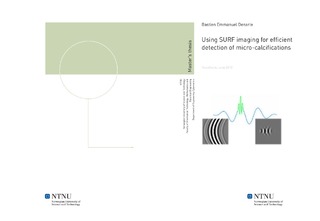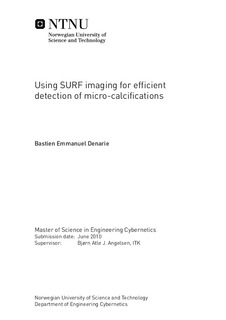| dc.description.abstract | The presence of clustered micro-calcifications is an important indicator of early stage breast cancers, and an efficient real-time ultrasound imaging support is needed for conducting needle biopsies. SURF is a dual-frequency band ultrasound technique capable of imaging nonlinear scattering using the superposition of a low-frequency pulse to manipulate the tissue characteristics and an imaging pulse to extract the informations. This new technique has already demonstrated its superiority in imaging high intensity nonlinear scatterers like ultrasound contrast agents compared to the classical methods. However, imaging lower intensity nonlinear scatterers like micro-calcifications requires the use of higher manipulation pressures, causing the apparition of complex distortions of the imaging pulse neglected hitherto. In order to achieve a sufficient level of tissue suppression and detect the micro-calcifications using SURF imaging, these nonlinear forward propagation effects must be characterized and corrected for. In this thesis, simulations have been conducted based on the geometry of the first manufactured prototypes of SURF probes, named Viglen and Okla. The nonlinear propagation effects were described as the regroupment of a nonlinear propagation delay due the average level of LF manipulation pressure experienced by the HF pulse, a mix of compressions/expansions of the imaging pulse resulting from the fluctuations of the LF manipulation pressure over the HF pulse, and a phenomenon of SURF aberration due to the difference in the focusing and diffraction pattern of the HF and LF beams. The build-up of these nonlinear propagation effects were shown to be fully characterized by the combination of the profiles of the LF beam and the phase-relation between the two pulses. The different beamforming strategies, with the superposition of a focused HF beam on a plane or co-focused LF beam, were also discussed: a net trade-off appears between the minimization of delays and SURF aberrations ensured by the co-focal configurations, and the minimization of compressions/expansions effects by using plane LF beams. A strategy to limit the nonlinear propagation effects would be the use of an especially designed transducer providing an excellent HF focusing in the study range and a sufficiently large LF aperture. A filter was then designed and tested to ensure a correction of the pulse-form distortions in the received signals. The filter improved the level of suppression of the linear scattering from tissue by 15 dB in the numerical simulations, allowing a theoretical detection of the micro-calcifications and raising the resolution of the imaging system up to 1 dB close to the noise floor. The same filter demonstrated a smaller suppression of only 7 dB with the experiments conducted on phantoms, 2 dB below the limit required for detecting the smallest micro-calcifications. Further work studying the pulse-form correction filter should be conducted to understand this difference in performances, along with a real-time implementation on the scanner, before achieving a correct detection of micro-calcification using SURF imaging. | nb_NO |

